精选2019-2020年小学三年级下册英语module 1 Using my five sensesunit 2 Touch and feeling牛津上海版巩固
- 格式:docx
- 大小:492.76 KB
- 文档页数:5
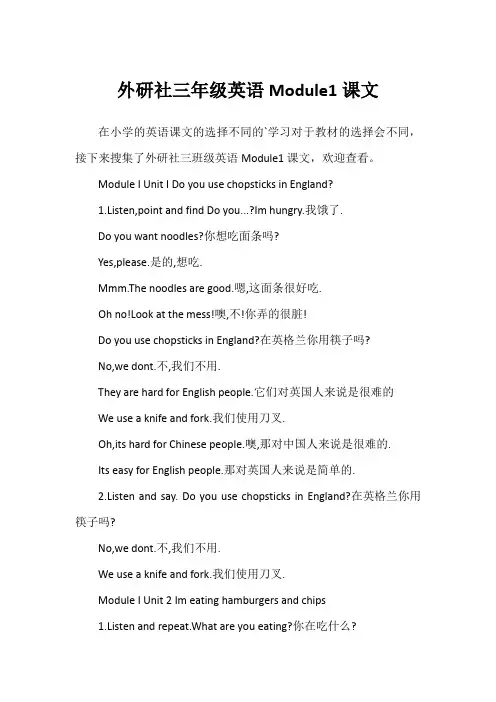
外研社三年级英语Module1课文在小学的英语课文的选择不同的`学习对于教材的选择会不同,接下来搜集了外研社三班级英语Module1课文,欢迎查看。
Module I Unit I Do you use chopsticks in England?1.Listen,point and find Do you...?Im hungry.我饿了.Do you want noodles?你想吃面条吗?Yes,please.是的,想吃.Mmm.The noodles are good.嗯,这面条很好吃.Oh no!Look at the mess!噢,不!你弄的很脏!Do you use chopsticks in England?在英格兰你用筷子吗?No,we dont.不,我们不用.They are hard for English people.它们对英国人来说是很难的We use a knife and fork.我们使用刀叉.Oh,its hard for Chinese people.噢,那对中国人来说是很难的.Its easy for English people.那对英国人来说是简单的.2.Listen and say. Do you use chopsticks in England?在英格兰你用筷子吗?No,we dont.不,我们不用.We use a knife and fork.我们使用刀叉.Module I Unit 2 Im eating hamburgers and chips1.Listen and repeat.What are you eating?你在吃什么?Im eating hamburgers and chips.Its English fast food.这是英国快餐.I like noodles.我喜欢面条.Its Chinese fast food.这是中国快餐.2.Listen, point and say.Daming is eating rice.大明在吃米饭. Hes using chopsticks.他用的是筷子.Lingling is eating noodles.玲玲在吃面条.Shes using chopsticks.她用的是筷子.Mrs Smart is eating meat and chips.Smart夫人吃肉和薯片Shes using a knife and fork.她用刀和叉.Amy is eating a hamburger.艾米在吃汉堡包.Shes using her hands.她用的是双手.Sam is eating sweets.萨姆在吃糖.Hes using his hands.他用的是双手.4.Listen and say.Then say the poem.You speak English.你说英语. We speak Chinese.我们说汉语.We use chopsticks. 我们用筷子.Try them, please.来试一试.We speak English.我们说英语.You speak Chinese.你们说汉语.We use a knife and fork.我们用刀和叉.Try them, please.来试一试.Module 1 Word List 单词表use使用chopsticks筷子fork叉easy容易的。
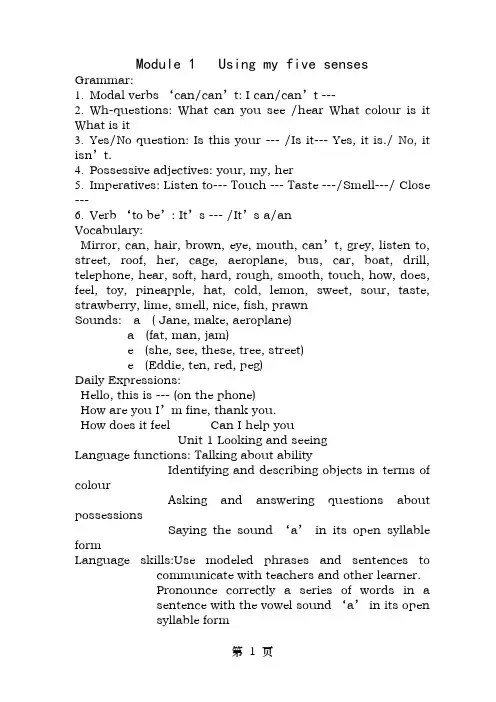
Module 1 Using my five senses Grammar:1.Modal verbs ‘can/can’t: I can/can’t ---2.Wh-questions: What can you see /hear What colour is it What is it3.Yes/No question: Is this your --- /Is it--- Yes, it is./ No, it isn’t.4.Possessive adjectives: your, my, her5.Imperatives: Listen to--- Touch --- Taste ---/Smell---/ Close ---6.Verb ‘to be’: It’s --- /It’s a/anVocabulary:Mirror, can, hair, brown, eye, mouth, can’t, grey, listen to, street, roof, her, cage, aeroplane, bus, car, boat, drill, telephone, hear, soft, hard, rough, smooth, touch, how, does, feel, toy, pineapple, hat, cold, lemon, sweet, sour, taste, strawberry, lime, smell, nice, fish, prawnSounds: a ( Jane, make, aeroplane)a (fat, man, jam)e (she, see, these, tree, street)e (Eddie, ten, red, peg)Daily Expressions:Hello, this is --- (on the phone)How are you I’m fine, thank you.How does it feel Can I help youUnit 1 Looking and seeingLanguage functions: Talking about abilityIdentifying and describing objects in terms of colourAsking and answering questions about possessionsSaying the sound ‘a’ in its open syllable formLanguage skills:Use modeled phrases and sentences to communicate with teachers and other learner.Pronounce correctly a series of words in asentence with the vowel sound ‘a’ in its opensyllable formMain points: Can use the sentences: What can you see/What colour is itDifficult points: Yes/No questions: Is this your ---Teaching beach:Using the old words and sentences to learn the new words and sentences.Using the things and pictures to learn the words.Teaching times: Five periodsThe First PeriodLanguage focus:Using nouns to identify different parts of the bodyUsing modal verb ‘can/can’t’ to talk about ability Language skills:Use modeled phrases and sentences to communicate with teacher and other learners.Open an interaction by asking questionsMain points: Can use the sentence “What can you see I can see---.〞Difficult Points: Can spell the words and using the sentence.Language focus: Using nouns to identify thingsUsing predicative adjectives of colour to describe thingsUsing modal verb ‘can’ to talk about abilityLanguage skills: Using modeled phrases and sentences to communicate with teacher and other learnersMaintain an interaction by replying to questionsMain points: Can spell the words and using the sentences. Difficult points: Can recite the words and write the sentences. Materials: some colour pencils, rulers, rubbers ---Language focus: Asking ‘Wh-‘ questions to find out various colours students see.Using modal verb ‘can’ to talk about abilityLanguage skills: Identify a series of words in a sentence with the vowel sound ‘a’ in its open syllable for mUsing modeled phrases and sentences to communicate with teacher and other learners.Main points: Can say the sentences. Pronounce correctly a series of words in a sentence with the vowel sound ‘a’ in its open syllable form.Difficult point: Can use the sentences.Language focus: Using possessive adjectives to show possession.Language skills: Use modeled phrases and sentences to communicate with teacher and other learners.Close an interaction by using appropriate formulaic.Main points: Can use possessive adjectives to show possession.Can ask and answer the sentences.Difficult points: Can contract my/your. Can copy the sentences.Language focus: Asking and answering questions about possessionsTalking about ability.Language skills: Use modeled phrases and sentences to communicate with teachers and other learners.Pronounce correctly a series of words in a sentence with theLanguage functions: Identifying objects by their sounds Responding to simple instructionsUsing telephone formulaeSaying the sound ‘a’ in its closes syllable form.Language skills: Open an interaction by eliciting a response Maintain an interaction by using phrases to replyMain points: Can use imperatives to give instructions anddirections.Can use the sentences to ask and answer.Difficult points: Can say and write the phrases .Teaching times: Five periodsThe First PeriodLanguage focus: Using imperatives to give instructions and directionsUsing nouns to identify things.Language skills: identify key words in an utterance by recognizing stress.Main point: Can spell and read the words.Can use imperatives to give instructions and directions. Difficult point: Can use the phrases .Language focus: Using imperatives to give instructions and directionsUsing nouns to identify things.Language skills: identify key words in an utterance by recognizing stress.Main point: Can make a new rhyme. Can say and recite the words.Difficult point: Can make a new phyme.Language focus: Using modal verb ‘can’ to talk about abilities.Asking ‘Wh-‘ questions to find out various kinds of specific information about a person.Language skills: Open an interaction by asking a question. Pronounce correctly a series of words in a sentence with the vowel sound ‘a’ in its closed syllable form.Main point: Can use modal verb ‘can’ to talk about abilities. Difficult point: Can ask ‘Wh-’ questions to find out var ious kinds of specific information about a person.Language focus: Using formulaic expressions to start a telephone conversation.Using formulaic expressions to greet people and respond to greetings.Using imperatives to give instructionsLanguage skills:Using modeled phrases or sentences to communicate with other learnersMaintain an interaction by replying to a question.Main point: Can use imperatives to give instructions.Difficult point: Use imperatives to give instructions. Materials: Cassette 3B and a cassette playerPreparation: Ask students to bring paper cups and pieces ofLanguage focus:Using modal verb ‘can’ to talk about abilities.Asking ‘yes/no’ questions using modal verb ‘can’ . Language skills:Use modeled phrases or sentences to communicate with other learners.Open an interaction by asking a question.Main point: Can use the sentences to ask and answer. Difficult point: Asking questions using modal verb ‘can’. Materials:Unit 3 Touching and feelingLanguage functions:Identifying objects by touchAsking questions about and describing the way things feel Identifying letters of the alphabet shapesResponding to simple instructionsSaying the sound ‘e’ in its open syllable form Language skills:Use modeled sentences to communicate with other learners Open an interaction by eliciting a responseProduce simple sentences involving listsPronounce correctly a series of words in a sentence with the vowel sounds ‘e’ in its open syllable formTeaching times: Five periodsThe First PeriodLanguage focus:Using adjectives to describe things.Using imperatives to give instructionsAsking ‘How’ questions to find out the texture of a thing. Asking ‘Wh-’ questions to find out a specific thing. Language skills:Maintain an interaction by replying to a question.Locate specific information in response to simple questions.The Second PeriodLanguage focus:Using adjectives to describe thingsUsing imperatives to give instructionsAsking ‘How’ questions to find out the texture of a thing Language skills:Locate specific information in response to simple questionsOpen an interaction by asking a questionMaintain an interaction by replying to a question Main point:Can use the question to find out the texture of a thing Difficult point:Can use two adjectives to describe things Materials:A soft toy, a bag, a balloon, an apple and a pineapple Cassette 3B, Photocopiable P6,7The Third PeriodLanguage focus:Asking ‘How’ questions to find out the texture of a thing Asking ‘yes/no’ questions to obtain simple responses Language skills:Locate specific information in response to simple questions Open an interaction by asking a questionMaintain an interaction by replying to a questionPronounce correctly a series of words in a sentence with the vowel sound ‘e’ i n its open syllable formMaterials:Cassette 3B Wallpictures 3B Workbook P7a cup of hot tea and some iceModule 1 Unit 4 Tasting and smellingLanguage functions:Indentifying objects by taste and smell.Asking questions about and describing the taste and smell of objectsResponding to simple instructionsSaying the sound ‘e’ in its closed syllable formLanguage skills:Use modeled sentences to communicate with teachers and other learnersOpen an interaction by eliciting a responsePronounce correctly a series of words in a sentence with the vowel sound ‘e’ in its closed syllable formTeaching breach: Use the fruits and the food to learn the words.Act and practice the sentences.Teaching times: Five timesThe First PeriodLanguage focus :Using nouns to identify thingsUsing adjectives to describe thingsUsing imperatives to give instructionsAsking ‘Wh-’ questions to find out a specific thin gs Language skills:Open an interaction by asking a questionMaintain an interaction by replying to a questionMain point: Using adjectives to describe thingsTeaching beach: Using the fruits and food to taste and try to say.Materials: a lemon , an apple, an orange, some chocolate, a knifeThe Second PeriodTeaching aims: Have the students to ask and answer the questions.Have the students to read the words and sentences. Language focus: Using nouns to identify thingsUsing adjectives to describe thingsAsking ‘Wh-’ questions to find out a specific thing Teaching breach: Using the things and practice.Materials: Cassette some ap0ples , some oranges , a lemon, a banana, a strawberry, a limeThe Third PeriodTeaching aims: Have the pupils to pronounce the words and vowel ‘e’ in closed syllable correc tly.Have the pupils to ask the feelings.Language focus: Using nouns to identify thingsUsing adjectives to describe thingsDifficult point: Can pronounce correctly a series of words in a sentence with the vowel sound ‘e’ in its closed syllable formMain Point: Can pronounce correctly a series of words in a sentence with the vowel sound ‘e’ in its closed syllable form Materials: a pineapple, a prawn, a dried prawn, sweets, cakes , different kinds of fruit.The Fourth PeriodTeaching aims: Have the pupils to act out the dialogue. Language focus: Using formulaic expressions to start a conversationUsing formulaic expressions to request somethingDifficult point: Using formulaic expressions to start a conversationMain Point: Can make a small dialogue about shopping Materials: some fruits cassetteModule 2 My favourite thingsUnit 1 Animals I likeLanguage focus: 1.Wh-questions: What are they2. Yes/No question: Do you like…3. Verb “to be〞: They are…4. Countable nouns(plual)Skills:Speaking e modelled phrases and senyences to communicate with a teacher and other learns2.Open an interaction by eliciting a response3. Maintain an interaction by providing informationto factual /yes/no questions4.Pronounce correctly a series of words in asentence with the vowel sound “i〞in its opensyllable formListening 1 Identify key words in an utterance by recognizing the stress2. Locate specific information in response to simple questions3. Identify a series of words in a sentence with thevowel sound〞i〞in its open syllable from.Writing Develop written text by reproducing sentencesfrom teacher’s writing.Diffcult points 1.Wh-questions: What are they2. Yes/No question: Do you like…3. Verb “to be〞: They are…4. Pronounce correctly a series of words in a seriesof words in a sentence with the vowel sound“i〞in its open syllable formTeaching aids: Pictures,tapeTeaching times fourFirst period: Look and learn, Look and say, Ask and answerSecond period: Look,red and say . Ask and answerThird period: Read and guess. Learn the sound Fourth period: ReviewFirst PeriodContents: words: cats , dogs, rabbits, lizards, snakes, birds Sentences: Do you like cats Yes, I like … No, I don’t like …I like… Language focus: Using nouns to identify different animals. E g. snakesUsing simple present tense to express interests and preferences.Ask yes/ no questions to obtain simpleresponses.Materials: pictures, recorderSecond PeriodContents: words: lions, tigers, zebras, elephants, giraffes, pandassentences: Do you like… Yes, I like …No, I don’t like …Language focus: Using nouns to identify different animals.eg. pandasUsing simple present tense to express interests and preferences.Ask yes/ no questions to obtain simple responses.Materials: pictures of animals, recorderThird PeriodContents: sentences:They’re tall/big/black/…What are they They’re____s. Language focus: Using adjectives to describe animals. eg. They’re tall.Ask “wh〞questions to find out about animals.eg. What are theyMaterials: pictures of animals., recorderFourth PeriodContents: Review Unit1Difficult points: Do you like… Yes,I like… No,I don’t like…What are they They are…Materials: recorderModule 2 My favourite thingsUnit 2 Toys I like: Language focus: 1 .Wh-questions: What do you like2. demonstratives: these, this3. pronoun: weSkills:Speaking e modelled phrases and senyences to communicate with a teacher and other learns2.Open an interaction by eliciting a response3. Maintain an interaction by providing informationto factual /yes/no questions4.Pronounce correctly a series of words in asentence with the vowel sound “i〞in its closedsyllable formListening 1 Identify key words by recognizing the stress2. Locate specific information in response to simple questions3. Identify a series of words in a sentence with thevowel sound〞i〞in its closed syllable from.Writing Develop written text by reproducing sentencesfrom teacher’s writing.Diffcult points 1.Wh-questions: : What do you like2. demonstratives: these, this3.Pronounce correctly a series of words in asentence with the vowel sound “i〞in its closedsyllable formTeaching aids: Pictures,tapeTeaching times fourFirst period: Look and say, Ask and answerSecond period: Read a story .Third period: Make a robot。
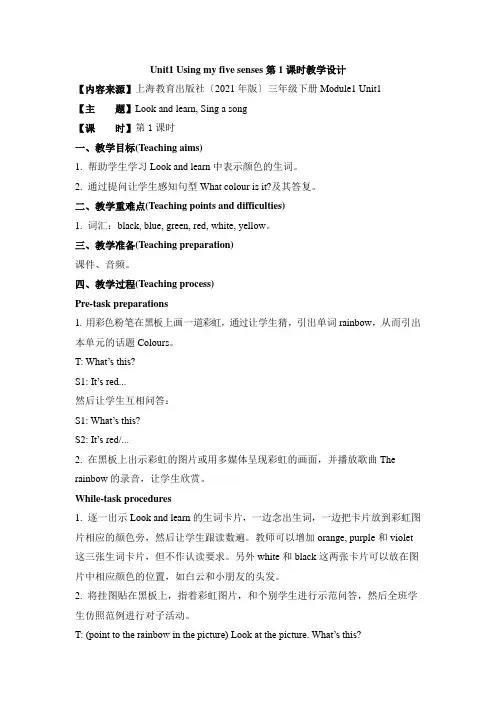
Unit1 Using my five senses第1课时教学设计【内容来源】上海教育出版社〔2021年版〕三年级下册Module1 Unit1【主题】Look and learn, Sing a song【课时】第1课时一、教学目标(Teaching aims)1. 帮助学生学习Look and learn中表示颜色的生词。
2. 通过提问让学生感知句型What colour is it?及其答复。
二、教学重难点(Teaching points and difficulties)1. 词汇:black, blue, green, red, white, yellow。
三、教学准备(Teaching preparation)课件、音频。
四、教学过程(Teaching process)Pre-task preparations1. 用彩色粉笔在黑板上画一道彩虹,通过让学生猜,引出单词rainbow,从而引出本单元的话题Colours。
T: What’s this?S1: It’s red...然后让学生互相问答:S1: What’s this?S2: It’s red/...2. 在黑板上出示彩虹的图片或用多媒体呈现彩虹的画面,并播放歌曲The rainbow的录音,让学生欣赏。
While-task procedures1. 逐一出示Look and learn的生词卡片,一边念出生词,一边把卡片放到彩虹图片相应的颜色旁,然后让学生跟读数遍。
教师可以增加orange, purple和violet 这三张生词卡片,但不作认读要求。
另外white和black这两张卡片可以放在图片中相应颜色的位置,如白云和小朋友的头发。
2. 将挂图贴在黑板上,指着彩虹图片,和个别学生进行示范问答,然后全班学生仿照范例进行对子活动。
T: (point to the rainbow in the picture) Look at the picture. What’s this?S1: It’s a rainbow.T: How many colours?S2: Seven.T: (point to the red colour) What colour is this?S3: It’s red.3. 带着学生朗读新句型What colour is it? 数遍,然后请学生进行对子活动,就挂图或身边的东西互相问答。
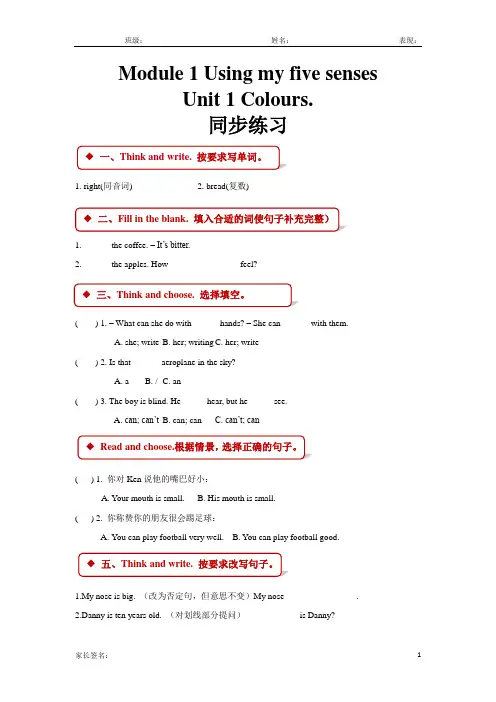
Module 1 Using my five sensesUnit 1 Colours.同步练习1. right(同音词) ________2. bread(复数) ________1.--_____ the coffee. – It’s bitter.2.--_____ the apples. How _____ _____ _____feel?( ) 1. – What can she do with______ hands? – She can ______ with them.A. she; writeB. her; writingC. her; write( ) 2. Is that ______ aeroplane in the sky?A. aB. /C. an( ) 3. The boy is blind. He _____ hear, but he _____ see.A. can; can’tB. can; canC. can’t; can( ) 1. 你对Ken 说他的嘴巴好小:A. Your mouth is small.B. His mouth is small.( ) 2. 你称赞你的朋友很会踢足球:A. You can play football very well.B. You can play football good.1.My nose is big. (改为否定句,但意思不变)My nose _______ _______.2.Danny is ten years old. (对划线部分提问)_____ _____ is Danny?参考答案1. right(同音词)_______write.2. bread(复数) ________breads.1. --_____ the coffee. – It’s bitter.Taste.2.--_____ the apples. How _____ _____ _____feel?Taste does the apple.( ) 1. – What can she do with______ hands? – She can ______ with them.A.she; writeB. her; writingC. her; writeC.( ) 2. Is that ______ aeroplane in the sky?A. aB. /C. anC.( ) 3. The boy is blind. He _____ hear, but he _____ see.B.can; can’t B. can; canC. can’t; canC.( ) 1. 你对Ken说他的嘴巴好小:A. Your mouth is small.B. His mouth is small.A.( ) 2. 你称赞你的朋友很会踢足球:B.You can play football very well. B. You can play football good.A.1.My nose is big. (改为否定句,但意思不变)My nose _______ _______. isn't small.2.Danny is ten years old. (对划线部分提问)_____ _____ is Danny?How old.。
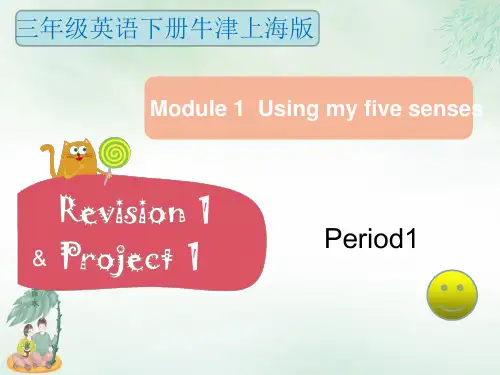


2019-2020学年人教精通版三年级英语下册全册单元知识点归纳与整理预览说明:预览图片所展示的格式为文档的源格式展示,下载源文件没有水印,内容可编辑和复制Unit Let’sgotoschool.一、核心词汇school学校classroom教室textbook课本storybook故事书Chinesebook语文书Englishbook英语书exercisebook练习本notebook笔记本desk课桌chair椅子二、了解词汇nice令人愉快的see看见again又,此外,再一次glad高兴的guess 猜look看new新的三、核心句型1.Let’sgotoschool.咱们去上学吧。
解读:这是表示提出建议的句子。
举一反三:Let’sgototheclassroom.咱们去教室吧。
Let’shaveatalk.咱们谈一谈吧。
2.Ihaveanewtextbook.我有一本新课本。
解读:这是一个表示我有某物的句型。
举一反三:Ihaveanewstorybook.我有一本新故事书。
IhaveanoldEnglishbook.我有一本旧英语书。
3.What’sinmybag?我的书包里面有什么?解读:这是一个询问某物里面有什么的句型。
举一反三:—What’sinyourhand?你的手里有什么?—AChinesebookandanEnglishbook.一本语文书和一本英语书。
—What’sinmypencil-box?我的铅笔盒里面有什么?—Somepencils.一些铅笔。
4.What’sonthechair?椅子上面有什么?解读:这是一个询问某物上面有什么的句型。
举一反三:What’sonthebed?床上面有什么?What’sonmydesk?我的课桌上面有什么?四、了解句型1.Nicetoseeyouagain.很高兴再次见到你。
解读:这是一个常见的打招呼用语。
句中的again表示“再次”。
![2019年精选新版-牛津上海版英语四年级下册[Module 1 Using my five sensesUnit 2 Smell and taste]习题精选](https://uimg.taocdn.com/b5e6a46faf45b307e87197d8.webp)
2019年精选新版-牛津上海版英语四年级下册[Module 1 Using my five sensesUnit2 Smell and taste]习题精选[含答案解析]六十七第1题【单选题】It is a watermelon.A、B、【答案】:【解析】:第2题【单选题】Do you have orange juice ______grape juice?A、orB、soC、but【答案】:【解析】:第3题【单选题】Is it orange juice _______watermelon juice?( )A、atB、orC、of【答案】:【解析】:第4题【单选题】It is a strawberry.A、B、【答案】:【解析】:第5题【判断题】shop和English这两个单词中的字母组合“sh”发音相同。
A、正确B、错误【答案】:【解析】:第6题【翻译】它是草莓汁还是西瓜汁?Is it ______________________________. 【答案】:【解析】:第7题【翻译】写出下列句子的意思。
How does it taste?______These grapes are very sweet.______【答案】:【解析】:第8题【翻译】I like grapes.【答案】:【解析】:第9题【单词拼写(词汇运用)】It is______juice. 【答案】:【解析】:第10题【语法填空】It cannot______(eat) it.【答案】:【解析】:第11题【语法填空】They are______(strawberry)【答案】:【解析】:。
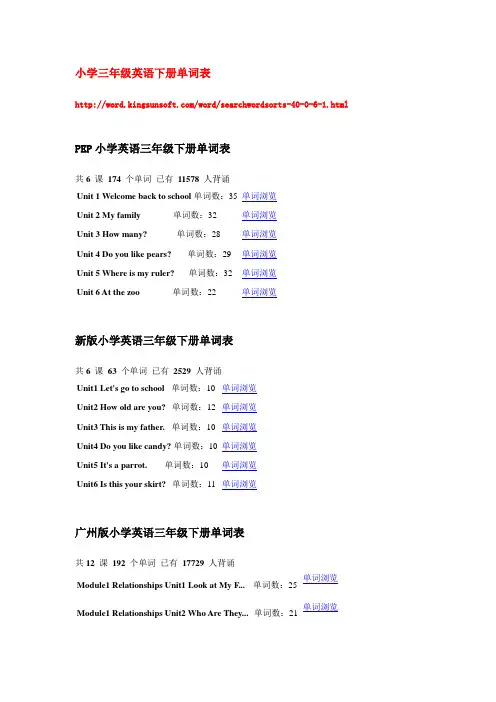
小学三年级英语下册单词表/word/searchwordsorts-40-0-6-1.html PEP小学英语三年级下册单词表共6课174个单词已有11578人背诵Unit 1 Welcome back to school 单词数:35 单词浏览Unit 2 My family 单词数:32 单词浏览Unit 3 How many? 单词数:28 单词浏览Unit 4 Do you like pears? 单词数:29 单词浏览Unit 5 Where is my ruler? 单词数:32 单词浏览Unit 6 At the zoo 单词数:22 单词浏览新版小学英语三年级下册单词表共6课63个单词已有2529人背诵Unit1 Let's go to school 单词数:10 单词浏览Unit2 How old are you? 单词数:12 单词浏览Unit3 This is my father. 单词数:10 单词浏览Unit4 Do you like candy? 单词数:10 单词浏览Unit5 It's a parrot. 单词数:10 单词浏览Unit6 Is this your skirt? 单词数:11 单词浏览广州版小学英语三年级下册单词表共12课192个单词已有17729人背诵单词浏览Module1 Relationships Unit1 Look at My F... 单词数:25单词浏览Module1 Relationships Unit2 Who Are They... 单词数:21Module2 Animals Unit4 We Like Your Farm 单词数:24 单词浏览Module2 Animals Unit5 I Have Cute Pets 单词数:9 单词浏览Module3 Nationalities Unit7 I Have Many ... 单词数:14 单词浏览Module3 Nationalities Unit8 Where Are Th... 单词数:10 单词浏览Module4 My Room Unit10 It Is My Bedroom 单词数:11 单词浏览Module4 My Room Unit11 Put the Table Aga... 单词数:22 单词浏览Module5 My House Unit13 Come in! 单词数:14 单词浏览Module5 My House Unit14 This Is My House... 单词数:12 单词浏览Module6 My School Unit16 Clean the Class... 单词数:15 单词浏览Module6 My School Unit17 Visit Our Schoo... 单词数:15 单词浏览冀教版小学英语(三年级起始)第二册单词表共4课77个单词已有1136人背诵UNIT 1 Food and More Numbers 单词数:26 单词浏览UNIT 2 Food and Restaurants 单词数:18 单词浏览UNIT 3 Clothes We Wear 单词数:21 单词浏览UNIT 4 At Home 单词数:12 单词浏览广东版开心学英语三年级下共9课96个单词已有3982人背诵Unit 1 Hello, Gogo! 单词数:9 单词浏览Unit 2 They're big. 单词数:9 单词浏览Unit 3 Do you like baseball? 单词数:9 单词浏览Unit 5 What's that? 单词数:11 单词浏览Unit 6 what are these? 单词数:11 单词浏览Unit 7 Where's my book? 单词数:11 单词浏览Unit 9 What time is it? 单词数:15 单词浏览Unit 10 How many are there? 单词数:10 单词浏览Unit 11 Do you have plates? 单词数:11 单词浏览重庆版小学英语三年级下共6课113个单词已有877人背诵Unit 1 School Days 单词数:20 单词浏览Unit 2 In the Classroom 单词数:19 单词浏览Unit 3 My Favorite Food 单词数:18 单词浏览Unit 4 My Family 单词数:19 单词浏览Unit 5 My Toys 单词数:19 单词浏览Unit 6 My Body 单词数:18 单词浏览湘少版三年级下册单词表共14课204个单词已有6934人背诵Unit 1 How are you? 单词数:10 单词浏览Unit 2 What's your number? 单词数:25 单词浏览Unit 3 How old are you? 单词数:8 单词浏览Unit 4 What's the time? 单词数:19 单词浏览Unit 5 How many pens are there? 单词数:17 单词浏览Unit 6 What colour is this balloon? 单词数:15 单词浏览Unit 7 This isn't my food. 单词数:13 单词浏览Unit 8 Is this a mango? 单词数:14 单词浏览Unit 9 I like a sunny day. 单词数:11 单词浏览Unit 10 It's a cold day. 单词数:15 单词浏览Unit 11 Look at the T-shirts. 单词数:16 单词浏览Unit 12 I come to school by bus. 单词数:19 单词浏览Unit 13 What shape is this? 单词数:8 单词浏览Unit 14 Here's a jumper. 单词数:14 单词浏览牛津上海小学英语(全国版)三年级下册单词表共10课116个单词已有1235人背诵Module 1 Using my five senses Unit 1 Lo... 单词数:8 单词浏览Module 1 Using my five senses Unit 2 Li... 单词数:13 单词浏览Module 1 Using my five senses Unit 3 Tou... 单词数:12 单词浏览Module 1 Using my five senses Unit 4 Ta... 单词数:10 单词浏览Module 2 My favourite things Unit 1 An... 单词数:9 单词浏览Module 2 My favourite things Unit 2 Toys... 单词数:9 单词浏览Module 2 My favourite things Unit 3 Peo... 单词数:14 单词浏览Module 3 Things around us Unit 1 Colour... 单词数:9 单词浏览Module 3 Things around us Unit 2 Noises 单词数:10 单词浏览Module 3 Things around us Unit 3 The sea... 单词数:22 单词浏览牛津上海小学英语(本地版)三年级下册单词表共4课183个单词已有5487人背诵Module 1 Using my five senses 单词数:46 单词浏览Module 2 My favourite things 单词数:50 单词浏览Module 3 Things around us 单词数:37 单词浏览Module 4 More things to learn 单词数:50 单词浏览北师大版小学英语三年级下册单词表共6课88个单词已有3983人背诵Unit 7 At the restaurant 单词数:13 单词浏览Unit 8 Big bird! 单词数:17 单词浏览Unit 9 Hot soup! 单词数:14 单词浏览Unit 10 Mocky's store 单词数:18 单词浏览Unit 11 Green berries 单词数:25 单词浏览Unit 12 Review 单词数:2 单词浏览江苏牛津小学英语3B共10课81个单词已有4740人背诵Unit 1 My school bag 单词数:8 单词浏览Unit 2 Yes or no 单词数:6 单词浏览Unit 3 Family members 单词数:9 单词浏览Unit 4 Time 单词数:12 单词浏览Unit 5 Plus and minus 单词数:8 单词浏览Unit 7 Where? 单词数:6 单词浏览Unit 8 I'm hungry 单词数:8 单词浏览Unit 9 Shopping 单词数:8 单词浏览Unit 10 Do you play…? 单词数:8 单词浏览Unit 11 A good idea 单词数:8 单词浏览深圳版小学英语第六册单词表共8课101个单词已有5613人背诵Unit 1 Our favourite subjects 单词数:12 单词浏览Unit 2 Pet corner 单词数:11 单词浏览Unit 3 My day 单词数:11 单词浏览Unit 4 Our lessons 单词数:12 单词浏览Unit 6 At home 单词数:14 单词浏览Unit 7 Helping at home 单词数:12 单词浏览Unit 8 At the market 单词数:16 单词浏览Unit 9 Planning a party 单词数:13 单词浏览冀教版小学英语(一年级起始)第六册单词表共4课103个单词已有1359人背诵UNIT 1 How do you feel? 单词数:20 单词浏览UNIT 2 My day 单词数:28 单词浏览UNIT 3 Shopping where I live 单词数:30 单词浏览UNIT 4 Healthy me! 单词数:25 单词浏览外研版小学英语(一年级起始)第六册单词表共10课81个单词已有6772人背诵Module1 单词数:11 单词浏览Module2 单词数:9 单词浏览Module3 单词数:4 单词浏览Module4 单词数:3 单词浏览Module5 单词数:13 单词浏览Module6 单词数:8 单词浏览Module7 单词数:9 单词浏览Module8 单词数:7 单词浏览Module9 单词数:9 单词浏览Module10 单词数:9 单词浏览新起点小学英语三年级下册单词表共6课85个单词已有13637人背诵Unit 9 My School 单词数:14 单词浏览Unit 10 My Classes 单词数:16 单词浏览Unit 11 After School Activities 单词数:13 单词浏览Unit 13 My Home 单词数:14 单词浏览Unit 14 My Family 单词数:18 单词浏览Unit 15 Family Activities 单词数:10 单词浏览。
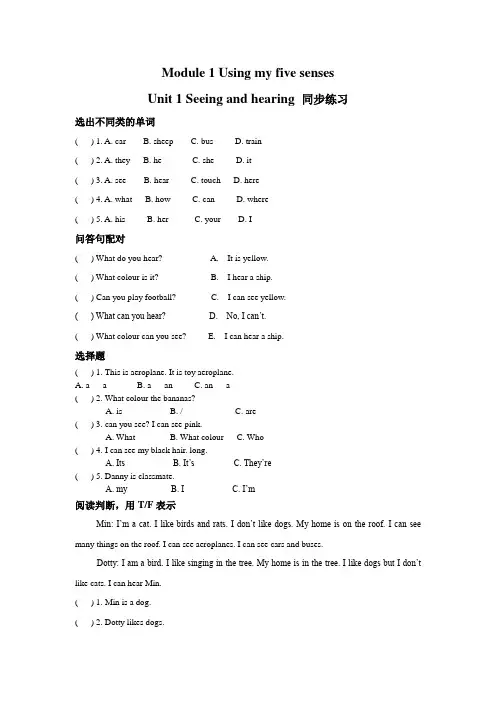
Module 1 Using my five sensesUnit 1 Seeing and hearing 同步练习选出不同类的单词( ) 1. A. car B. sheep C. bus D. train( ) 2. A. they B. he C. she D. it( ) 3. A. see B. hear C. touch D. here( ) 4. A. what B. how C. can D. where( ) 5. A. his B. her C. your D. I问答句配对( ) What do you hear? A. It is yellow.( ) What colour is it? B. I hear a ship.( ) Can you play football? C. I can see yellow.( ) What can you hear? D. No, I can’t.( ) What colour can you see? E. I can hear a ship.选择题( ) 1. This is aeroplane. It is toy aeroplane.A. a aB. a anC. an a( ) 2. What colour the bananas?A. isB. /C. are( ) 3. can you see? I can see pink.A. WhatB. What colourC. Who( ) 4. I can see my black hair. long.A. ItsB. It’sC. They’re( ) 5. Danny is classmate.A. myB. IC. I’m阅读判断,用T/F表示Min: I’m a cat. I like birds and rats. I don’t like dogs. My home is on the roof. I can see many things on the roof. I can see aeroplanes. I can see cars and buses.Dotty: I am a bird. I like singing in the tree. My home is in the tree. I like dogs but I don’t like cats. I can hear Min.( ) 1. Min is a dog.( ) 2. Dotty likes dogs.( ) 3. Min and Dotty are good friends.( ) 4. Dotty can hear a cat.( ) 5. Min’s home is in the tree.翻译句子1.你可以听到什么?______________________________________2.你可以看到什么?______________________________________3.我看到一辆公共汽车和一些汽车。
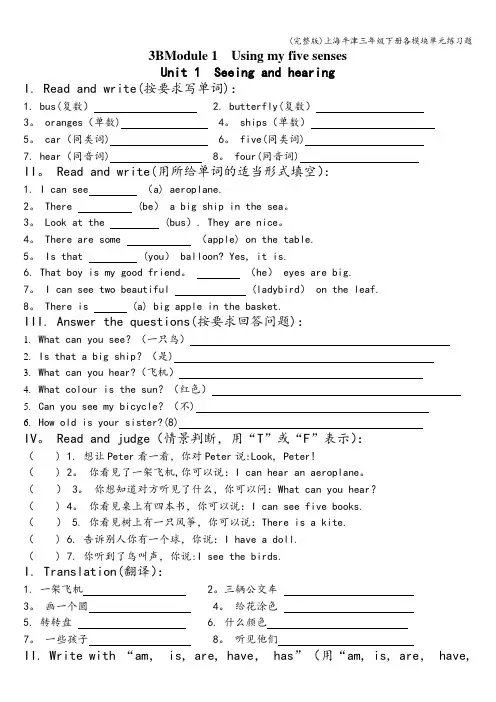
3BModule 1 Using my five sensesUnit 1 Seeing and hearingI. Read and write(按要求写单词):1. bus(复数)2. butterfly(复数)3。
oranges(单数) 4。
ships(单数)5。
car(同类词) 6。
five(同类词)7. hear(同音词) 8。
four(同音词)II。
Read and write(用所给单词的适当形式填空):1. I can see (a) aeroplane.2。
There (be) a big ship in the sea。
3。
Look at the (bus). They are nice。
4。
There are some (apple) on the table.5。
Is that (you) balloon? Yes, it is.6. That boy is my good friend。
(he) eyes are big.7。
I can see two beautiful (ladybird) on the leaf.8。
There is (a) big apple in the basket.III. Answer the questions(按要求回答问题):1.What can you see?(一只鸟)2.Is that a big ship?(是)3.What can you hear?(飞机)4.What colour is the sun?(红色)5.Can you see my bicycle?(不)6.How old is your sister?(8)IV。
Read and judge(情景判断,用“T”或“F”表示):( ) 1. 想让Peter看一看,你对Peter说:Look, Peter!( ) 2。
你看见了一架飞机,你可以说:I can hear an aeroplane。
小学三年级英语下册单词表0-6-1.html
PEP小学英语三年级下册单词表
共6 课 174 个单词已有 11578 人背诵
新版小学英语三年级下册单词表
共6 课 63 个单词已有 2529 人背诵
广州版小学英语三年级下册单词表
共12 课 192 个单词已有 17729 人背诵
冀教版小学英语(三年级起始)第二册单词表共4 课 77 个单词已有 1136 人背诵
广东版开心学英语三年级下
共9 课 96 个单词已有 3982 人背诵
重庆版小学英语三年级下
共6 课 113 个单词已有 877 人背诵
湘少版三年级下册单词表
共14 课 204 个单词已有 6934 人背诵
牛津上海小学英语(全国版)三年级下册单词表共10 课 116 个单词已有 1235 人背诵
牛津上海小学英语(本地版)三年级下册单词表共4 课 183 个单词已有 5487 人背诵
北师大版小学英语三年级下册单词表
共6 课 88 个单词已有 3983 人背诵
江苏牛津小学英语3B
共10 课 81 个单词已有 4740 人背诵
深圳版小学英语第六册单词表。
上海牛津英语三年级下学期单元测试题3BModule 1 Using my five sensesUnit 1 Seeing and hearingI. Read and write(按要求写单词):1. bus(复数)2. butterfly(复数)3. oranges(单数)4. ships(单数)5. car(同类词)6. five(同类词)7. hear(同音词) 8. four(同音词)II. Read and write(用所给单词的适当形式填空):1. I can see (a) aeroplane.2. There (be) a big ship in the sea.3. Look at the (bus). They are nice.4. There are some (apple) on the table.5. Is that (you) balloon? Yes, it is.6. That boy is my good friend. (he) eyes are big.7. I can see two beautiful (ladybird) on the leaf.8. There is (a) big apple in the basket.III. Answer the questions(按要求回答问题):1.What can you see?(一只鸟)2.Is that a big ship?(是)3.What can you hear?(飞机)4.What colour is the sun?(红色)5.Can you see my bicycle?(不)6.How old is your sister?(8)IV. Read and judge(情景判断,用“T”或“F”表示):( ) 1. 想让Peter看一看,你对Peter说:Look, Peter!( ) 2. 你看见了一架飞机,你可以说:I can hear an aeroplane. ( ) 3. 你想知道对方听见了什么,你可以问:What can you hear? ( ) 4. 你看见桌上有四本书,你可以说:I can see five books. ( ) 5. 你看见树上有一只风筝,你可以说:There is a kite. ( ) 6. 告诉别人你有一个球,你说:I have a doll.( ) 7. 你听到了鸟叫声,你说:I see the birds.I. Translation(翻译):1. 一架飞机2.三辆公交车3. 画一个圆4. 给花涂色5. 转转盘6. 什么颜色7. 一些孩子8. 听见他们II. Write with “am, is, are, have, has”(用“am, is, are, have, has”填空):1. Who that girl? She Alice.2. Ben my friend. We good friends.3. There an aeroplane in the sky.4. Tom a bicycle. It black.5. The children many books. They new.III. Read and write(按要求改变句子):1. The little boy can make a spinner.(否定句)The little boy a spinner.2. Danny can see a black dog.(划线提问)Danny see?3. My father has got a black car.(一般疑问句)your father a black car?4. I can hear raindrops.((划线提问)can you ?IV. Reading(阅读理解,用“T”或“F”表示):Hello, I’m a parrot. I’m in the cage. I’m small. But I’m fat. My mouth is red. My feather(羽毛) is green. My tail is long. I’m very beautiful. I can sing. I like apples. But I’m not happy.( ) 1. This is a parrot.( ) 2. It likes oranges.( ) 3. It’s fat and big.( ) 4. Its tail is short.( ) 5. Its mouth is red and green.Unit 1 单元练习I. Copy the sentence(正确抄写句子,注意大小写及标点符号):what can you see kitty i can see some orangesII. Read and write(按要求写单词):1. bus(复数)2. sheep(复数)3. hear(同音词)4. see(同音词)5. children(单数)6. leaves(单数)7. they(宾格) 8. I(宾格)9. cannot(缩写) 10. bus(同类词)III. Choose the best answer(选择):( ) 1. I have old bag. It’s too small.A. aB. anC. /( ) 2. What colour can you see? I can see orange.A. aB. anC. /( ) 3. In the zoo, I can see a lion some tigers too.A. butB. andC. /( ) 4. There some sweets in the box.A. amB. isC. are( ) 5. There is in the sky.A. a bicycleB. a ballC. a balloon( ) 6. I hear a bird, but I see it.A. can, canB. can, can’tC. can’t, can’t( ) 7. Can you play football, children?A. Yes, I can.B. Yes, we can.C. Yes, you can.( ) 8. is the butterfly? It’s blue.A. WhatB. What colour C How( ) 9. can you see? I can see a red kite.A. WhatB. What colourC. Where( ) 10. How many ? Three.A. dressB. dressesC. a dressIV. Copy the sentence (正确抄写下列句子,注意大小写及标点符号): i can hear an aeroplane but i cant see it_______________________________________________________________V. Read and choose(将划线部分发音不同的单词的编号写在前面括号内):1.( ) A. bag B. animal C. cake2.( ) A.Christmas B.children C. much3.( ) A.ship B.toothpick C. bicycle4.( ) A. bus B. use C.up5.( ) A. he B.ten C. elseVI. Read and write (按要求写出内容):1. hear (同音词)__________________2. see(同音词)____________ _____3. bus(复数)__________________4. children (单数)__________________5.car(同类词)________________6. have(第三人称单数形式)_________7.can(否定形式)_______________ 8. listen ( 近义词) ___________ ______VII. Read and write (任意填空,每格一词):1.What colour can you see? I can see_________________.2.It’s rainy. What can you hear? I can hear____________________.3.Charlie has a _______________. It’s so lovely.4.How many birds? ________________.5.There is a __________________ by the window.VIII. Read and judge(阅读短文并完成判断,用“T ”或“F”表示): Spring is coming. It’s warm. The sun is shining. My friends and I are in the park. The park is very big and beautiful. I can see the green grass. There are many nice flowers on the grassland. I see a red kite .Peter and Jane are flying the kite. Oh, there is an aeroplane. It’s high in the sky. Tweet, tweet, the birds are singing. I can hear them. We have a good time in the park.1. ( ) It’s spring. We feel warm.2. ( ) We are in the small park.3. ( ) There are many beautiful flowers in the park.4. ( ) I can see a blue kite and a high aeroplane in the sky.5. ( ) I can hear the birds.Module 1 Using my five sensesUnit 2 Touching and feelingI. Read and write(按要求写单词):1. soft(反义词)2. rough(反义词)3. glass(复数)4. child(复数)5. leaves(单数)6. them(单数)7. pineapple(同类词) 8. cake(同类词)II. Read and write(用所给单词的适当形式填空):1. Touch the cake. How (do) it feel?2. Feel the (cake). They’re soft.3. Miss Fang (have) two bananas.4. Where’s my bag? I (can) see it.5. There (be) three pupils under the tree.III. Read and write(按要求改变句子):1.The desk is smooth.(否定句,意思不变)The desk .2.This apple is red.(划线部分提问)is the apple?3.This apple is hard.(划线部分提问)this apple ?4.4. I can hear a bicycle. (划线部分提问)you hear?IV. Reading(阅读理解,回答问题):Peter has a yellow box. It’s big and nice. It’s a present from his mother. Open it and see. There is a toy car in the box. This car is very nice. It is black andshiny. Touch it. It’s hard and smooth. Peter like s it very much.1.Does Peter have a big box?2.What colour is the box?3.Where is the toy car?4.Is the toy car black?5.How does the toy car feel?I. Translation(翻译):1.三只杯子2.一些面包3.又硬又粗糙4.一个大菠萝5.摸摸桌子6.太硬7.在月球上8.月亮派II. Choose and write with “am, is, are, have, has, do, does”(用“am, is, are, have, has, do, does”选择填空):1. How the pineapple feel? It rough.2. I a dog. My sister a cat.3. How the balloons feel? They soft.4. Where you now? Here I .5. The ant six legs. They black.III. Answer the questions(根据要求回答问题):1.What can you see?(一个苹果)2.What’s this?(一只风筝)3.What colour is the umbrella?(橙色)4.How does the pineapple feel?(又硬又粗糙)5.How much are the dolls?(十元)IV. Read and write(按要求改变句子):1.These bananas are yellow.(划线提问)are these bananas?2.My father’s car is smooth.(否定句,意思不变)My father’s car .3.Can Supergirl fly on the Moon?(肯定句)Supergirl on the Moon.Unit 2 单元练习I. Copy the sentences (正确抄写下列句子,注意大小写及标点符号) :1. look theres a supermarket___________________________________________________________2. how do they feel theyre smooth_____________________________________________________________II. Think and write(根据要求写出相应内容):1.there’s (完整形式)___________2.glass (复数)________________ _3. touch(同类词)______________4. do ( 第三人称单数形式)_______ __5. cake(同类词)_______________6. ship( 划线部分发音相同的词)_______7. hard ( 反义词)______________8. smooth(反义词)_______________ III. Read and choose the best answer (选择正确的答案):( )1. I _________a bag and three books.A. hasB. amC. have( )2. There _________ some bread on the table.A. areB. isC. isn’t( )3. Touch the desk. It’s ___________.A.sweetB. niceC. hard( )4. How _________ the bag feel?A. doB. doesC. is( )5. I’m hungry. I want a ____________.A. apple pieB.breadC. cake( )6. How much? _______________.A. There are ten.B. Ten yuan.C. ten( ) 7. May I have a toy ship? ________________.A. No, thanks.B. It’s hard.C. Sure.( ) 8. This banana is soft, ___________ that one isn’t.A. orB. but C andIV. Read and write(用所给单词的适当形式填空):1. Look, there (be) two aeroplanes in the sky.2. Danny (can) see a tree, but he (can) see a bird.3. I can see two paper (bus).4. My (dress) are nice. I like them very much.5. I have ten (finger). I can (touch) with them.6. What (be) in your bag? There (be) some bread.7. How (do) the desk feel? Hard.V. Read and write(按要求改变句子):1. I can see red and black.(划线提问)can you see?2. My cake is soft.(否定句,意思不变)My cake .3. The apple is smooth and hard.(划线提问)the apple feel?4. This is a red apple.(划线提问)is this?VI. Reading(阅读理解,用“T”或“F”表示):Hello, my name is Wang Jun. My English name is Kitty. I’m ten years old. I’m a girl. I have short hair, big black eyes, a small nose, asmall mouth and white teeth. I like reading books. I like apples. I’mhappy.( ) 1. Wang Jun is a boy.( ) 2. Kitty is ten.( ) 3. Kitty has long hair and a small nose.( ) 4. Wang Jun has two big black eyes.Module 1 Using my five sensesUnit 3 Tasting and smelling I. Write the words(按要求写单词):1. sweet(反义词)2. rough(反义词)3. lemon(同类词)4. sour(同类词)5. sweet(复数)6. salt(形容词)7. smell(同类词) 8. peach(复数)II. Choose the best answer(选择正确的答案):( ) 1. I am . I want some sandwiches.A. hungryB. thirstyC. tired( ) 2. Close your . Taste it.A. eyeB. eyesC. mouth( ) 3. What is it? It’s orange.A. aB. anC. /( ) 4. Taste the . It’s sour.A. lemonB. coffeeC. salt( ) 5. Smell . Is it nice?A. the lemonsB. the lemonC. lemonIII. Answer the questions(按要求回答问题):1.What is this?(苹果)2.How does the apple feel?(又硬又光滑)3.What are they?(柠檬)4.How do they taste?(酸的)5.Is it a peach?(不,桔子)6.What are they?(公交车)I. Translation(翻译):1. 水果店2. 张开眼3. 尝尝苹果4. 苦的咖啡5. 酸柠檬6. 多少7. 多少8. 又矮又瘦II. Choose and write(用所给单词的适当形式填空,每词限用一次):1. Kitty eight nice flowers.2. What can you see? Grey.3. The lemon is very .4. the apple. It’s sweet .5. How does it ? It’s soft.III. Choose the best answer(选择正确的答案):( ) 1. Taste the apples. They are .A. sweetB. a sweetC. sweets( ) 2. How the balloon feel? It’s soft.A. isB. doC. does( ) 3. I’m hungry. Give me some , please.A. breadB. milkC. water( ) 4. I can with my nose.A. smellB. touchC. taste( ) 5. If you drink coffee at night, you sleep.A. /B. canC. can’t( ) 6. Is this your doll? No, it isn’t doll.A. myB. yourC. herUnit 3 单元练习I. Copy the sentences (正确抄写下列句子,注意大小写及标点符号) :1. how does it smell_______________________________________________________2. dont drink coffee at night_______________________________________________________II.Translation(中英互译):1.品尝柠檬_____________________2. 苦的咖啡_______________ _____3. 一条玩具鲸鱼_________________4. at the fruit shop__________________5. at night ________________ _____6. its white tail_____________________ III.Think and write(根据要求写出相应内容):1. smell( 同类词) _______________2. bitter ( 反义词)_______________3. salty ( 同类词) _______________4. it ( 复数) _________ _____ ____5. white(划线发音相同)___ __ _6. photograph(同义词) ______ ___7. fat(反义词) 8. libraries(原形)IV.Read and choose(情景选择):1.你请别人品尝一下蛋糕,该怎么说?( )A. Smell the cake, please.B. Taste the cake, please.2.在商店里,你问营业员菠萝一共多少钱,该怎么问?( )A. How many lemons?B. How much are the lemons?3.爸爸问你这个巧克力苦吗,他怎么问?( )A. How does it taste?B. Is it bitter?4.你的朋友问你柠檬闻起来怎么样,她怎么问?( )A. How does it feel?B. How does it smell?5.你告诉你的朋友你能听见飞机的声音,该怎么说?( )A. I can hear an aeroplane.B. What can you hear?6. 告诉妈妈你饿了,你该怎么说?()A. I’m hungry.B. I’m thirsty.7. 老师请你开门,她说:( )A. Open the door, please.B. Open the window, please.V. Read and write(用所给单词的适当形式填空):1. I (be) a girl. My hair (be) long.2. Close (you) eyes. You (can) see.3. Miss Li (have) a car. (she) car is red.4. Grandma has (a) old box. There are some (dress) in it.5. The (sweet) are (sweet).VI. Read and write(按要求改变句子):1.Here are the leaves.(单数句)Here the .2.The milk is hot.(否定句,意思不变)The milk .3.The coffee is bitter.(划线提问)the coffee ?4.Can Ben touch the apple?(肯定句)Ben the apple.5.That Moon pie is three yuan.(划线提问)is that Moon pie?VII.Read and complete the sentences(读短文,完成句子,每格一词):There is some water in a bottle. A bird is very thirsty. He comes to the bottle. But he can’t drink the water. Because the bottle’s neck (瓶颈) is very long. So he thinks(想)and thinks, and then he flies away.After some time, he comes back with a small stone(石头)in his mouth.He puts it into the bottle. He flies away and flies back again and again.He puts many stones into the bottle. The water comes up and the birdcan drink water. He’s very happy.1.There is some ______________ in the bottle.2.The bird is ____________.3.He can’t drink the water because the bottle’s neck is too ____________.4.The bird puts ____________into the bottle.5.At last, the bird ____________ drink water.Test of Module 1, Book 3B班级___________姓名_____________Part 1 Listening 听力部分I. Listen and choose.听录音,写出你听到的句子的编号。
Module Using my five senses一、核心词汇1. 水果名词: strawberry 草莓watermelon 西瓜grape 葡萄2. 时间名词: noon 中午evening傍晚;晚上night 夜晚minute 一会儿;分钟3. 名词: noise响声;吵闹声fox狐狸shadow影子 moon 月亮sky 天空4. 感官动词: touch 碰;触摸feel 摸起来;感到smell 闻;嗅5. 动词: wait等待;等候get得到rise升起stop停下6. 形容词: soft 柔软的hard 坚硬的thick厚的;粗的thin薄的;细的blind 瞎的;失明的young 年轻的round 圆的purple紫色的high 高的7. 副词: again再;又8. 代词: those 那些him他9. 连词: or 或者;还是10. 短语: at noon 在中午go down 落下at night 在夜晚take a walk 散步二、拓展词汇1. 颜色名词: white 白色black 黑色red 红色green 绿色yellow黄色2. 水果名词: apple 苹果pear 梨banana 香蕉3. 名词: sun 太阳star 星星4. 动词: see 看见taste 品尝hear 听5. 形容词: long 长的short 短的sweet 甜的sour 酸的old 老的三、核心句型1. — How does it feel? 感觉如何?— It’s soft. 它是柔软的。
解读:这是询问对某物的触觉感觉的句型及其回答。
举一反三:— How do the apples feel? 这些苹果你感觉如何?— They are hard. 它们是硬的。
2. — What is it? 它是什么?— It’s a toy bear. 它是一只玩具熊。
解读:这是询问物品名称的句型及其回答。
三年级下册英语书九模块一单元的作文篇1Unit 1: How can I get there?In unit 1 of Module 9 in the Grade 3 English textbook, students learn how to ask for and give directions. This unit introduces new vocabulary related to transportation and directions, such as bus stop, subway station, turn left, turn right, go straight, etc. Students also learn different modes of transportation and practice using prepositions to describe locations.The unit starts off with a dialogue between two friends, Peter and Mary, who are trying to meet at the park. Peter asks Mary for directions on how to get there, and Mary explains step by step using prepositions and simple directions. This dialogue helps students understand how to ask for directions and also how to give them.After the dialogue, students are given a variety of activities to practice using the new vocabulary and grammar structures. They may be asked to draw a map of their neighborhood and label different locations, or they may work in pairs to role-playgiving directions to each other. These activities encourage students to use the language in a meaningful context and help them remember the vocabulary better.At the end of the unit, there are usually some listening and speaking exercises to assess students' understanding of the material. They may listen to a recording of someone giving directions and answer questions, or they may work in pairs to create their own dialogues asking for and giving directions to different locations.Overall, Unit 1 in Module 9 is a fun and interactive way for students to learn how to ask for and give directions in English. It provides them with the necessary vocabulary and grammar structures to navigate their way around a city or town and helps them improve their listening and speaking skills. By the end of the unit, students should feel more confident in their ability to communicate in English when asking for directions.篇2Module 1 of Unit 9 in the English textbook for the third grade in the lower semester is an important module that focuses on introducing new vocabulary related to animals and theirhabitats. In this module, students will learn about different animals and their characteristics, as well as where they live.To begin with, students will be introduced to new vocabulary such as 'forest', 'ocean', 'desert', 'polar region', 'jungle', and'grassland'. They will learn about the different habitats where animals can be found and will be able to match the animals to their respective habitats. This will help them understand the relationship between animals and their environment.Next, students will learn about different animals and their characteristics. They will learn about animals such as tigers, elephants, giraffes, penguins, and polar bears. They will also learn about the different features of these animals and how they adapt to their habitats. For example, they will learn that polar bears have thick fur to keep them warm in cold climates, while giraffes have long necks to reach tall trees for food.In addition to learning about animals and their habitats, students will also learn how to describe animals using adjectives. They will be able to describe the size, color, and characteristics of animals, allowing them to practice forming complete sentences in English.Overall, Module 1 of Unit 9 is an engaging and interactive module that will help students expand their vocabulary, improvetheir language skills, and develop a deeper understanding of the natural world. By the end of this module, students will be able to confidently talk about animals and their habitats in English.篇3Module Nine Unit One in the third grade English book of the second semester is all about food. In this unit, students learn about different types of food, healthy eating habits, and how food is related to their daily lives.Firstly, students are introduced to various food items such as fruits, vegetables, meat, dairy products, and grains. They learn the names of different foods in English and practice saying them out loud. This helps them improve their vocabulary and pronunciation skills.Next, students learn about the importance of eating a balanced diet. They are taught about the different food groups and their nutritional benefits. They also learn about the concept of "My Plate" which shows the recommended portions of each food group for a healthy meal.In addition, students are encouraged to try new foods and explore different flavors. They learn about the cultural significance of food and how it is a way to connect with others.They also practice describing food using adjectives to express their likes and dislikes.Overall, this unit helps students develop a better understanding of food and its importance in their lives. They learn about healthy eating habits, food diversity, and cultural aspects of food. By the end of the unit, students are able to talk about their favorite foods, make healthy food choices, and appreciate the different flavors and tastes that food has to offer.。
精选2019-2020年小学三年级下册英语module 1 Using my five sensesunit 2 Touch and feeling牛津上海版巩固辅导第十六篇
第1题【阅读理解】
阅读短文并判断正误
Tom
is seven. He goes to school every day. The school is near his home. So he walks
there and comes back on time. But today he is late. His mother asks him,
"Why are you late today? I am in the headmaster"s office." "Why
do you go to the headmaster"s office? Because my teacher asks us a question in
class, and nobody can answer it, but I can." "It"s good to answer the
teacher"s questions." "But the question is "Who puts ink on my chair"?"
Tom"s home is not farfrom his school.
A、正确
B、错误
Tom goes to school bybicycle.
A、正确
B、错误
Tom often comes homeon time.
A、正确
B、错误
Tom"s classmates cananswer the teacher"s question.
A、正确
B、错误
Tom puts ink on the teacher"schair.
A、正确
B、错误
【答案】:无
【解析】:
第2题【句型转换】
Jim can cook. (改为否定句)
【答案】:
【解析】:
第3题【句型转换】
I have got a black dog. (改为一般疑问句) 【答案】:
【解析】:
第4题【选词填空(词汇运用)】
用I, you, he, she, it, my, your, her, we, they填空
______am a tall girl. This is ______bag.
—Are the pupils athome? —No, ______are at school.
Mary is a girl. ______has a bike. ______bike is red.
—What"s this? — ______is a nice toy.
—Who is that man? — ______is my father.
—Are you pupils? —Yes,______are.
【答案】:无
【解析】:
第5题【单词拼写(词汇运用)】
正确抄写下列句子,注意大小写和标点符号danny what can you hear i can hear a plane ______
【答案】:
【解析】:
第6题【单词拼写(词汇运用)】
看图填空,每格一词。
This is my______. There is a on the wall. You can see many______and chairs. There are some______in it. Our classroom is______and clean. I______my classroom.
【答案】:
【解析】:
第7题【音标题】
比较划线部分的发音,相同的用“T”表示,不同的用“F”表示
1)______bag face
2)______bread read
3)______cake apple
4)______touch but
【答案】:
【解析】:。